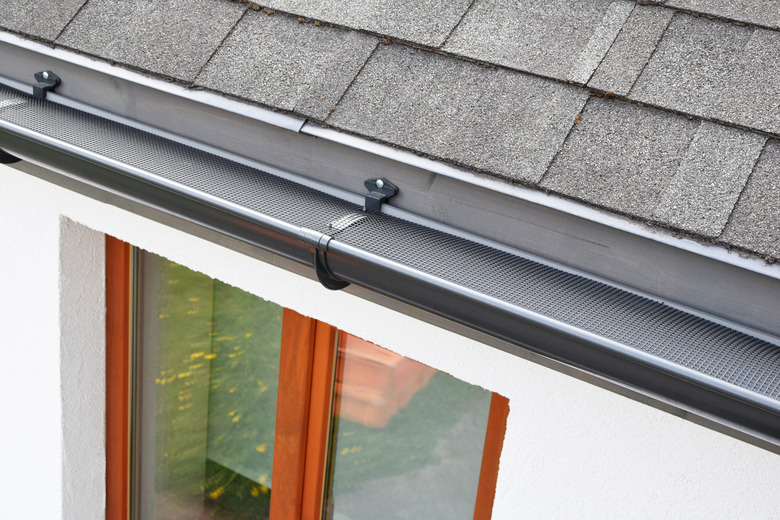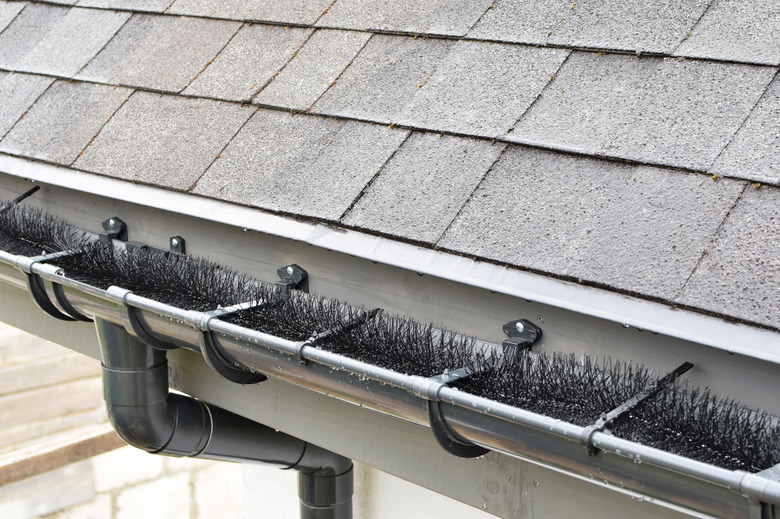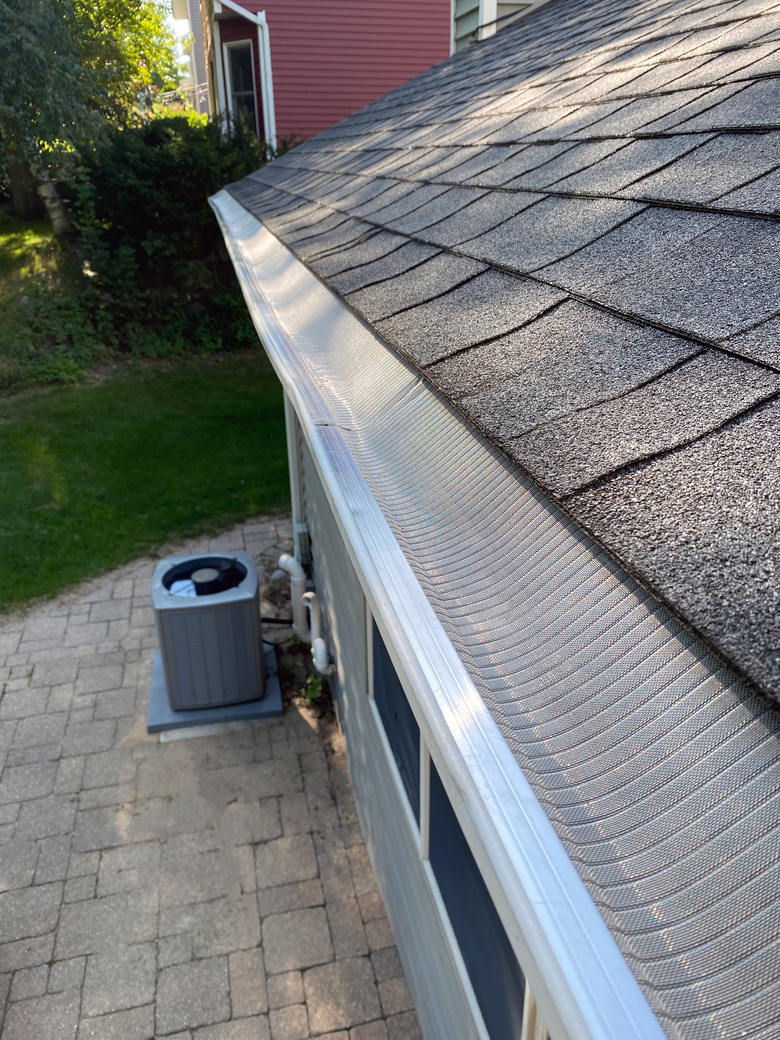Gutter Guards Pros And Cons: Are They Worth It?
We may receive a commission on purchases made from links.
Fall is that magical time of year when you find yourself standing on a ladder elbow deep in the gunk accumulated in your gutters, pondering whether or not gutter guards are worth it. Although they certainly seem like a good idea at this precise moment, the answer isn't quite so simple. There are several different types of gutter guards, and all have their own pros and cons to consider. It's a decision you should definitely research once you're off the ladder and safely back inside.
Pros of Gutter Guards
Pros of Gutter Guards
There are different types of gutter guards, and some have unique benefits. Several universal benefits apply to gutter guards in general, however. One such benefit is that gutter guards are made for retrofit installation. You don't need to start from scratch and incur the expense of new gutters — you can install any type of gutter guard on your existing gutters.
Of course, all gutter guards serve to keep leaves and debris out of your gutters, which they do with varying success. Preventing debris and the resulting water buildup in your gutters extends their useful life by helping to prevent rust and rot. This also helps eliminate a potential breeding ground for mosquitoes. By slowing down the accumulation of stuff in your gutters, guards also reduce the frequency of gutter cleanings.
Cons of Gutter Guards
Cons of Gutter Guards
Just as there are some universal pros of gutter guards, there are also some common cons. Gutter guards can reduce the frequency of gutter cleanings, but they won't eliminate them altogether. Tiny seeds, pine needles, and other small items inevitably find their way into your gutters and will still need to be removed, albeit less frequently. Unfortunately, guards can make cleaning your gutters more difficult.
You may not want to stick your hand in your gutters, but you can if you need to. Unless they're hinged or easy to pop on and off, gutter guards make it difficult if not impossible to clean your gutters well. Gutter guards can also make ice damming issues worse, and they lose their effectiveness if they become dented or dinged. To prevent damage to the guards, you'll also need to be extra careful when using a ladder to hang holiday lights or when you're performing other tasks that require leaning a ladder against your house.
Screen and Micro-Mesh Gutter Guards
Screen and Micro-Mesh Gutter Guards
As their name suggests, screen gutter guards are just that. These strips of screen get tucked up under the bottom layer of roofing shingles, the weight of which holds the guards in place. Screen gutter guards are inexpensive and work to keep out leaves, nesting animals, and large debris while allowing in rainwater.
Because you just slip them under your shingles, screen gutter guards make for an easy DIY install. Unfortunately, the lack of nails or clips means they're just as easy for Mother Nature to uninstall. If you live in a windy area, expect to find your gutter guards in the lawn frequently. Check your roofing information before installing these as well. Sliding things up under your shingles can void the warranty on your roof.
Micro-mesh gutter guards are similar to screens but have smaller holes that allow them to block smaller objects from getting into your gutters. This is handy when you have tiny leaves, like those of the locust tree, or pine needles. Micro-mesh screens can even block grains of sand, but this can be a blessing and a curse. Because they're capable of catching such fine particles, they can become clogged and may need to be hosed off occasionally.
Reverse-Curve Gutter Guards
Reverse-Curve Gutter Guards
Made of lightweight metal or plastic, reverse-curve guards, sometimes called gutter helmets, feature a curved edge that rests at the outside edge of the gutter. The theory is that as water runs along the gutter, it curves with the gutter guard and flows into the gutter while leaves and other debris slide off the edge and fall to the ground. These guards work well for keeping leaves out of the gutter but are visible from the ground. As such, it's important to choose a set that matches your home and blends in.
Reverse-curve gutter guards generally work well but aren't great for DIY installs. If the gutter guard isn't positioned just right, the water will run down the curve and spill over the gutter rather than into it. The result is a wet basement and foundation.
Brush-Style Gutter Guards
Brush-Style Gutter Guards
The strategy behind brush-style gutter guards is to catch leaves and other debris before they make it all the way into the gutter. They resemble giant pipe cleaners and keep debris suspended above your gutters rather than in them. These large wire brushes are flexible, so they can bend where your gutters do. Simply place them in your gutters and cut them to size if you have more brush than gutter.
These brushes are incredibly easy to install and inexpensive to buy, but they are not super effective at keeping gutters clean. They're only effective against large debris and still allow pine needles, seeds, and other small particles into your gutter. The large leaves and matter that get trapped on top of the brush can prevent rain from entering the gutter and need to be removed frequently if you have a lot of trees nearby.
Foam Gutter Guards
Foam Gutter Guards
Inexpensive and easy to install, foam gutter guards are triangular blocks of foam that sit in the gutter. The angled side of the foam faces out away from the building and directs water into the gutter. The foam lets water seep through and down into the gutter while preventing debris from doing the same.
The flaw in foam is that it can only process water so fast. Once it's saturated and can no longer absorb any more water, rain simply runs off it and may overflow the gutter. If you live in an area with a lot of heavy rain, foam gutter guards are likely to cause more problems than they solve.
Gutter Guard Materials
Gutter Guard Materials
Several different materials can be used to manufacture gutter guards, so there may be a few more choices to make after you've decided which type of gutter guard you want. Micro-mesh, screen, and reverse-curve metals are all available in stainless steel. This makes them a bit more expensive, but stainless steel resists rust and corrosion. It won't expand or contract during extreme weather either, so you need not worry about cracking or warping.
Copper mesh and screens are harder to find but may be worth considering. Like stainless, copper resists rust and lasts a very long time. Aluminum is also an option. It's not as durable or able to resist fallen tree branches or other sources of damage, but aluminum works well where you don't have branches overhanging the gutters.
Like many things built today, gutter guards are sometimes made of plastic. Plastic is less expensive than other materials but is also less durable. It won't rust, of course, but it could warp, swell, or crack.
Gutter Guard Installation
Gutter Guard Installation
Foam and brush gutter guards simply sit in the gutter and as such are easy to install. Screen gutter guards slide under the bottom layer of shingles, and micro-mesh guards do the same, although some micro-mesh guards snap onto the gutter. Although these guards all install quite simply, you may want to opt for a professional installation for gutter guards on the second story or higher.
The reverse-curve gutter guards are the most difficult to install. In order to work properly, these gutter guards must match the angle of your roof to keep water flowing the right way. To achieve this, many gutter guard installers bring their tools to your home and form your gutter guards on-site before installing them. Stiff brackets then mount the gutter guard to the gutter and the roof while helping the gutter guard keep its shape.
Gutter Guard Costs
Gutter Guard Costs
Gutter guards vary significantly in cost, so your budget can certainly affect your decision about what kind to get. Screens cost about $1.50 to $3.50 per linear foot. Micro-mesh runs a little higher at $2 to $4 per linear foot. Professional installation for both adds another $2.50 to $3.75 per linear foot.
Brush guards cost $3 to $4.25 per linear foot but have no added installation costs, as installing them is very much a DIY project. You won't incur labor charges for foam for the same reason, but expect to pay $2 to $3.25 per linear foot for the materials. Reverse-curve guards are the most expensive choice at $3.50 to $6.50 per linear foot. Professional installation is recommended, which adds labor costs of $2.25 to $12 per linear foot.
Are Gutter Guards Worth it?
Are Gutter Guards Worth it?
The unfortunate reality is that gutter guards generally aren't worth it from a financial standpoint. Reverse-curve gutter guards work the best, but they just aren't cost effective if you do the math. On average, paying someone else to clean your gutters for you costs between 40 cents and $2.15 per linear foot, with the average being 80 cents. Now, let's say you can get a reverse-curve guard installed for $10 per linear foot.
At these rates, if you have 200 linear feet of gutter, it costs $160 to pay someone else to clean your gutters once a year and $2,000 to install a gutter guard. At this cost, it would take 12 1/2 years for your reverse-curve gutter guards to pay for themselves — and remember that you'll still need periodic gutter cleanings.
Foam guards can create more problems when they get wet, and brushes simply aren't that effective. Valuewise, screens or micro-mesh are the most worthwhile. They're fairly inexpensive, and they do help, even though they can't prevent gutter cleaning altogether. Buyer beware, however. These stop being a good value if their installation requires you to do anything that may void your roof warranty.


